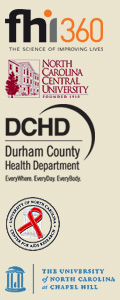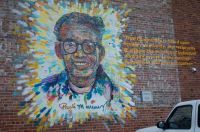
| Project News and Events | |
| Other Events and Activities | |
| Resources | |
| Get Involved | |
| Contact Us | |

|
|
Project Information
Who has HIV hit hardest?
In the United States, the HIV/AIDS epidemic is a health crisis for Black Americans. According to the Centers for Disease Control and Prevention (CDC):
- There are about 56,300 new cases of HIV in the United States every year, and Black Americans account for the largest share—almost half (46 percent) of new infections. Yet Blacks make up only about 12 percent of the total U.S. population.
- Black men bear the greatest burden of HIV. For every 100,000 Black men, 2,388 were living with HIV at the end of 2006. This was six times the rate for White men living with HIV (395 per 100,000). In 2007, the rate of AIDS diagnoses for Black men was almost eight times the rate for White men.
- Black women are also severely affected. For every 100,000 Black women, 1,122 were living with HIV at the end of 2006. This was 18 times the rate for White women living with HIV (63 per 100,000). In 2007, the rate of AIDS diagnoses for Black women was 22 times the rate for White women.
- Although Black teens (ages 13 to 19) represent only 15 percent of U.S. teenagers, they accounted for 68 percent of new AIDS cases reported among teens in 2007.
- Of the nearly 25,000 infections estimated to occur each year among Black Americans, more than one-third (38 percent) are among young people ages 13 to 29.
According to the North Carolina Department of Health and Human Services (NCDHHS):
- In 2009, Blacks represented 65 percent of all new HIV cases (1,118 of 1,710) in North Carolina. According to the 2009 North Carolina STD/HIV Surveillance Report (PDF, 4.45 MB), Durham County has the fourth-highest HIV infection rate in North Carolina with 86 new infections reported in 2009.
 |
| Photograph by Lisa Marie Albert |
What is LinCS 2 Durham doing about HIV prevention?
Scientists are working to prevent the spread of the virus that causes AIDS but can't do this alone. People at risk of HIV or who are living with the virus, community leaders, and health workers must be partners. To make a real difference, communities affected by HIV and scientists need to work together.
In the 1990s, the first Project LinCS: Linking Communities and Scientists brought people together in Durham and elsewhere to talk about HIV vaccines. LinCS 2 Durham HIV Prevention is building on that experience. It gives members of Durham's Black community and scientists in the region a chance to work together on new ways to prevent HIV.
The LinCS 2 Durham partnership is a five-year research project that began in late 2008, undertaken by FHI, North Carolina Central University (NCCU), the Durham County Health Department (DCHD), the University of North Carolina at Chapel Hill Center for AIDS Research (UNC CFAR), and the University of North Carolina at Chapel Hill (UNC). The National Institute of Nursing Research, part of the National Institutes of Health, is providing the funding for this study.
By bringing together researchers and community members, we're accomplishing three goals:
- We're talking to people in the Durham community about medical research and HIV. Our goal is to help build support for new HIV-prevention work in the Black community and especially among people who have the highest chance of becoming infected. We want to find out what would encourage or discourage people from participating in HIV-prevention research. We want to understand concerns people have about HIV, medical care, and medical research. We want to work together to address those concerns.
- We're talking with the communities of young Black adults (ages 18 to 30) who have a higher chance of becoming infected with HIV. Most importantly, we want to understand what affects people's trust in medicine, medical research, and public-health programs. Our goal is to understand these problems so that they can be solved.
- We're bringing community members and scientists together to decide jointly what research needs to be done to prevent HIV in the Black community. Members of Durham's Black community and researchers are forming a strong team. Working together, we'll identify one or more HIV-prevention studies to plan and pursue.
 |
| Photograph by Lisa Marie Albert |
Who's participating in this project?
LinCS 2 Durham takes place in Durham County. The headquarters is at NCCU, and FHI is managing the study. Researchers from FHI, NCCU, DCHD, UNC CFAR, and UNC have hosted meetings and focus groups with people in the community to learn about their opinions and concerns. Later, we may also conduct interviews with individuals. A group called the Collaborative Council has been formed to provide support and to participate in decisions related to the project. The Collaborative Council meets at least once a month. We invite you to join.
We're recruiting young Black adults to participate in this project in order to gain insight into their communities and the groups to which they feel connected. We also seek insight into HIV-related behaviors, issues of trust, the factors that guide people's decisions to participate in HIV-research studies, and attitudes toward HIV testing. We're making connections with organizations that are working to prevent HIV and with groups that serve people who have the virus.
| Contact the Webmaster | Feedback Form | Subscribe to Our E-newsletter | Terms of Use | Home |